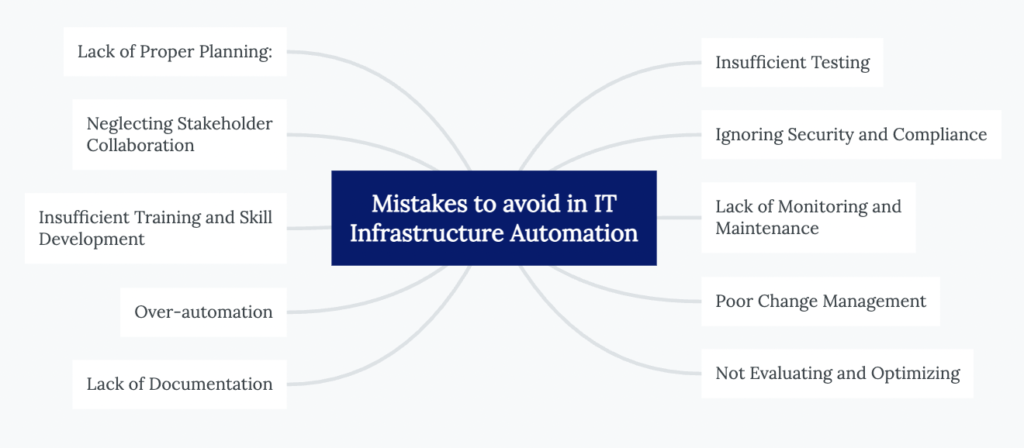As businesses expand, the management of IT infrastructure becomes increasingly burdensome and expensive. IT infrastructure encompasses multiple components, including applications and data centers. To ensure smooth operations, IT infrastructure needs to be provisioned, configured, and integrated with various processes. However, relying on manual handling of these tasks introduces the risk of human errors and leads to bottlenecks and inefficiencies.
Implementing automation for IT infrastructure management can address these challenges. Automation minimizes the potential for human error, enhances security measures, and improves overall performance. By automating these processes, organizations can streamline their IT operations, reduce costs, and achieve greater efficiency.
Successful Case of AWS Infrastructure Automation
One noteworthy example of successful IT infrastructure automation can be seen in the collaboration between Gart, an IT infrastructure and DevOps consulting firm, and CyberiSight, a cybersecurity company. CyberiSight sought to build a robust CI/CD pipeline for their web application hosted on AWS, and they turned to Gart for their expertise in AWS infrastructure automation.

Gart’s team took on the challenge of implementing automation solutions to streamline the code deployment, testing, and database update processes for CyberiSight. By leveraging AWS infrastructure automation tools and practices, Gart successfully built a seamless CI/CD pipeline tailored to CyberiSight’s needs.
The project involved the initial setup of automated deployment and the creation of necessary infrastructure components. Gart implemented a robust CI/CD pipeline that facilitated code updates across different environments, running tests, and performing database updates. In addition, Gart integrated security tasks, such as dependency checks and application scanning, into the pipeline to ensure the highest level of security for CyberiSight’s web application.
This case study exemplifies the power of AWS infrastructure automation in enhancing the efficiency and reliability of IT operations. By leveraging automation tools and practices, organizations can achieve remarkable outcomes like the seamless CI/CD pipeline implemented for CyberiSight. The success of this collaboration demonstrates the transformative impact of IT infrastructure automation when applied to AWS environments.
? Read more: Building a Robust CI/CD Pipeline for Cybersecurity Company
Benefits of IT Infrastructure Automation
As organizations strive to keep up with increasing demands, optimize efficiency, and drive innovation, automation emerges as a crucial solution. By leveraging automation tools and practices, businesses can streamline their operations, enhance productivity, and unlock a multitude of benefits.
Here’s a table outlining the benefits of IT infrastructure automation:
| Benefits | Description |
| Increased Efficiency | Automation streamlines routine tasks, reducing manual effort and allowing IT teams to focus on more strategic activities. |
| Improved Scalability | Automation enables organizations to scale their infrastructure easily, accommodating growing demands and facilitating the adoption of cloud computing. |
| Enhanced Reliability | Automation reduces human errors, ensuring consistent configurations and minimizing downtime, thereby improving system reliability. |
| Cost Savings | Automation optimizes resource utilization, reducing the need for manual intervention and resulting in long-term cost savings. |
| Accelerated Deployment | Automation facilitates faster and more consistent application and service deployment, enabling organizations to deliver value to users quickly. |
| Increased Agility | Automation allows for agile infrastructure changes and adaptability, enabling organizations to respond quickly to evolving business needs. |
| Simplified Management | Automation simplifies the management of complex IT environments, providing centralized control and visibility into the infrastructure. |
| Improved Security and Compliance | Automation helps enforce security measures and ensures compliance with industry regulations through consistent configurations and monitoring. |
| Enhanced Collaboration | Automation promotes collaboration between IT teams and other stakeholders, enabling better coordination and communication in managing infrastructure. |
| Better Resource Utilization | Automation optimizes resource allocation and usage, ensuring efficient utilization of infrastructure components such as servers, storage, and network resources. |
Cost Savings
Automation in IT infrastructure brings significant cost savings by optimizing resource utilization and reducing the need for manual intervention.
One of the key advantages of automation is its ability to optimize resource utilization. Automation tools can analyze and assess resource usage patterns, allowing organizations to allocate resources more efficiently. By automating resource provisioning and scaling based on demand, organizations can avoid overprovisioning and underutilization, thereby optimizing their infrastructure costs. The ability to scale resources dynamically based on workload fluctuations ensures that resources are allocated precisely when needed, avoiding unnecessary expenses.
Additionally, automation reduces the need for manual intervention in routine and repetitive tasks. Manual interventions require time and effort from IT personnel, who can then focus on higher-value activities. By automating these tasks, organizations can free up their IT teams to focus on strategic initiatives, innovation, and delivering higher business value. This increased productivity translates into cost savings by making the most efficient use of skilled resources.
Furthermore, automation helps minimize human errors that can lead to costly mistakes or system failures. Manual processes are inherently prone to human errors, whereas automation follows predefined configurations and workflows consistently. By reducing errors and ensuring accurate execution, automation mitigates the risks associated with costly downtime, troubleshooting, and rework.
? Ready to unlock the benefits of IT infrastructure automation for your organization? Contact Gart today and take the first step towards streamlined operations, increased efficiency, and improved reliability.
Increased Efficiency and Productivity
Automation plays a pivotal role in boosting efficiency and productivity within IT infrastructure management. By automating routine tasks and reducing manual effort, organizations can streamline their operations and free up valuable time and resources. Repetitive and time-consuming activities, such as software installations, system configurations, and provisioning of resources, can be automated, eliminating the need for manual intervention.
Automation empowers IT teams to focus on more strategic and value-added activities that drive innovation and deliver business value. With routine tasks taken care of by automation, IT professionals can dedicate their time and expertise to activities that require critical thinking, problem-solving, and decision-making. This shift in focus allows teams to proactively address complex challenges, drive process improvements, and innovate within the organization.
Moreover, automation brings consistency and accuracy to processes. By following predefined configurations and workflows, organizations can ensure standardized and reliable outcomes. Manual errors and inconsistencies that may arise from human intervention are minimized, leading to improved quality and reliability of IT operations.
Improved Scalability and Flexibility
Automation empowers organizations to achieve enhanced scalability and flexibility in managing their IT infrastructure. With automation in place, organizations can seamlessly scale their infrastructure to accommodate growing demands and handle fluctuations in workloads.
Automation enables swift provisioning and deployment of resources, allowing organizations to rapidly scale their infrastructure as needed. With just a few clicks or through programmable scripts, new servers, virtual machines, storage, and network resources can be provisioned automatically. This eliminates the need for manual intervention and significantly reduces the time and effort required to scale the infrastructure.
Additionally, automation plays a pivotal role in the adoption of cloud computing and hybrid environments. Cloud platforms provide a vast array of services that can be dynamically provisioned and deprovisioned. Automation tools, such as Terraform and CloudFormation, enable organizations to define and manage their infrastructure as code, allowing for consistent and repeatable deployment across different cloud providers. This flexibility allows organizations to take full advantage of the scalability and elasticity offered by the cloud.
Automation also facilitates the management of hybrid environments, where organizations maintain a combination of on-premises infrastructure and cloud resources.
? Let our experts guide you in implementing the right automation solutions tailored to your needs. Reach out to us now and revolutionize your IT infrastructure.
Enhanced Reliability and Consistency
Automation plays a vital role in improving the reliability and consistency of IT infrastructure by reducing human errors and ensuring consistent configurations across systems.
Human errors are inevitable when performing manual tasks, which can lead to misconfigurations and potential system failures. However, automation minimizes these errors by executing predefined workflows and configurations accurately and consistently. By defining standardized processes and configurations, organizations can eliminate the variations and inconsistencies that often arise from manual interventions. As a result, the risk of errors is significantly reduced, leading to improved reliability and stability of the IT infrastructure.
Consistency is a key aspect of reliable IT operations. Automation ensures that the same configurations and workflows are applied consistently across multiple systems and environments. This not only simplifies management but also reduces the likelihood of configuration drift, where systems deviate from the desired state over time. By enforcing consistent configurations, organizations can maintain a stable and reliable IT environment, ensuring that systems perform optimally and as intended.
Furthermore, automation plays a crucial role in minimizing downtime. By automating routine maintenance tasks, updates, and patch management, organizations can reduce the need for manual interventions that often require system downtime. Automation enables scheduled and non-disruptive updates, ensuring that critical services and applications remain available to users. Additionally, automated monitoring and alerting systems promptly identify and notify IT teams about potential issues, enabling proactive troubleshooting and minimizing the impact of incidents on system reliability.
10 Common Mistakes to Avoid in IT Infrastructure Automation

By avoiding these common mistakes, organizations can enhance the success and effectiveness of their IT infrastructure automation initiatives.
Lack of Proper Planning: Failing to plan and define clear goals for automation can lead to inefficient processes and suboptimal outcomes. It is important to identify the specific areas to automate and set realistic expectations.
Neglecting Stakeholder Collaboration: Not involving all relevant stakeholders, such as IT teams, developers, and operations personnel, can hinder the success of automation initiatives. Collaboration and input from all key parties ensure that automation aligns with their needs and requirements.
Insufficient Training and Skill Development: Automation requires expertise in specific tools and technologies. Not investing in training and upskilling of IT teams can result in underutilization or improper use of automation tools, limiting the potential benefits.
Over-automation: Attempting to automate every aspect of IT infrastructure without proper evaluation can be counterproductive. It is crucial to identify suitable processes for automation based on their complexity, frequency, and impact on overall operations.
Lack of Documentation: Failing to document automation processes, configurations, and changes can lead to confusion and difficulties in troubleshooting issues. Proper documentation ensures clarity, ease of maintenance, and knowledge transfer within the organization.
Insufficient Testing: Inadequate testing of automated workflows and configurations can lead to unexpected errors or failures. Thoroughly test automation processes in different scenarios to ensure reliability and minimize the risk of disruption.
Ignoring Security and Compliance: Automation should incorporate security measures and comply with regulatory requirements. Neglecting security aspects can leave systems vulnerable to breaches, data loss, or non-compliance issues.
Lack of Monitoring and Maintenance: Automated processes should be regularly monitored to detect any issues or deviations. Failure to maintain and update automation workflows can result in outdated configurations and increased risks.
Poor Change Management: Inadequate change management practices can disrupt the stability and consistency of the infrastructure. Proper controls and procedures should be in place to manage changes, updates, and rollbacks effectively.
Not Evaluating and Optimizing: Automation initiatives should be continuously evaluated and optimized for ongoing improvement. Regularly assess the effectiveness of automation processes, gather feedback, and make necessary adjustments to maximize the benefits.
Key Components of IT Infrastructure Automation
IT infrastructure automation is a strategic approach that empowers organizations to streamline their IT operations, improve efficiency, and enhance overall productivity. At the core of this approach are the key components of IT infrastructure automation, which encompass a range of tools, technologies, and practices designed to automate and optimize various aspects of the IT infrastructure lifecycle.
Here’s a table outlining the key components of IT infrastructure automation:
| Components | Description |
| Configuration Management | Tools that automate the management and configuration of infrastructure components, ensuring consistency and reducing manual effort. |
| Orchestration and Provisioning | Tools that automate the provisioning and deployment of infrastructure resources, enabling Infrastructure-as-Code (IaC) practices. |
| Monitoring and Alerting | Systems that provide automated monitoring of infrastructure components, generating alerts and notifications for proactive issue detection. |
| Continuous Integration and Deployment | Tools that automate the integration and deployment of applications and services, enabling streamlined and efficient CI/CD pipelines. |
| Infrastructure Monitoring | Tools that monitor and track the performance and health of infrastructure components, providing visibility into system metrics and performance indicators. |
| Compliance and Security | Automation tools and practices that ensure adherence to security policies and regulatory compliance requirements in managing infrastructure. |
| Incident Management | Tools and processes for automating the detection, response, and resolution of incidents and issues in the IT infrastructure, minimizing downtime and disruption. |
| Backup and Disaster Recovery | Automation solutions for performing regular backups and facilitating efficient disaster recovery processes, ensuring business continuity and data protection. |
| Cloud Orchestration | Tools and frameworks that automate the provisioning and management of cloud resources and services, enabling efficient cloud infrastructure management. |
| Network Automation | Automation tools for managing and configuring network infrastructure, including routers, switches, firewalls, and load balancers, to optimize network operations. |
IT Infrastructure Automation Tools
- Ansible is a widely used open-source automation platform that simplifies infrastructure automation, application deployment, and configuration management.
- Puppet is a powerful automation tool that allows organizations to define and enforce infrastructure configurations consistently.
- Chef is a configuration management tool that helps automate the deployment and management of infrastructure and applications.
- Terraform is an Infrastructure-as-Code (IaC) tool that enables provisioning and management of infrastructure resources across various cloud providers and on-premises environments.
- Kubernetes is an open-source container orchestration platform that automates the deployment, scaling, and management of containerized applications.
- Jenkins is a widely adopted open-source tool for continuous integration and continuous delivery (CI/CD).
- Nagios is a popular open-source monitoring and alerting tool used for infrastructure monitoring.
These are just a few examples of the many IT infrastructure automation tools available in the market. Organizations should assess their specific requirements and choose tools that align with their infrastructure, workflows, and desired automation goals.
? Read more: Best Infrastructure as Code Tools for Streamlined Management
Implement Automation with Our Help
With Gart’s expertise, you can successfully implement automation in your infrastructure. Our proven track record spans various industries, equipping us with the knowledge to build compelling business cases for automation. By partnering with us, you can achieve quick wins, cost savings, and simplified infrastructure management. Reach out to our consultants, who will guide you through every stage of the automation journey.









